We were up bright an early the next morning - all of us having gotten a good sleep at our "low" elevation of 8500 feet - so we could get out of camp by 8:00am. Mike @Digiratus was even up early enough to make himself a cup of coffee before packing up - quite the feat, when Dan @drr, Monte @Blackdawg, Devin @MissBlackdawg and I were up as late as we could possibly be in order to still be ready to roll!
The reason for our early departure was that we had an actual plan for the day. Actually, we'd discussed a plan for the rest of the week, and in order to make it work, we needed to be in Ouray for an early-ish lunch. That meant we wouldn't be able to take dirt roads from our current position just east of Ute Pass - rather, we'd hop on the highway for nearly 200 miles - but we all agreed that it was the best course of action if we were to really enjoy some of the highlights that the Alpine Loop had to offer.
And so, the sun rose above the horizon, we found ourselves cresting Ute Pass and heading towards Saguache, Colorado - and ultimately to CO-114, US-50, and US-550 to get us to our destination.

Dropping down off of Ute Pass, the smoke that had lingered the last few days was still with us, unfortunately.

All aired up with somewhere to go!
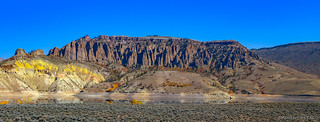
Dillon Pinnacles - a geologic phenomenon of southern Colorado. Volcanic eruptions formed the breccia rock into towering spires above the Blue Mesa Reservoir.

The dramatic entrance to Ouray, on US-550.
In Ouray, the plan was to fill up on gas and water and then hit up a local park where we could make lunch before getting on the trail. Fortunately, a lack of parking, and Devin's desire for a not-prepared-by-her meal found us parked outside of a local eatery where we spoiled ourselves on bacon-avocado-cheeseburgers (among other things) that were significantly better than those we'd had in Buena Vista.

And then, we were off. The Alpine Loop is a trail system that I've wanted to run for some time, but even as we were airing down at the Mineral Creek trailhead, I had no idea how moving the next few days were going to be. The trails really are some of the more beautiful I've run and they epitomize what I think of when I think "Colorado."
I apologize in advance for all the photos. I really couldn't help myself - not when taking them, nor culling for edit.







Not far up the trail we ran into our first mining ruin. Part of the Michael Breen Mine, established in the 1870s. It was during this period - after the Civil War - that an influx of miners rapidly settled southwest Colorado, resulting in conflict with the local Ute Indians. Even after the Treaty of 1868 resulted in the establishment of the Ute Reservation in western Colorado (including the San Juan Mountains), miners continued to trespass - fueling hostilities. Finally, in 1873, the Utes were pressed into surrender under the Brunot Agreement - signed by Chief Ouray in 1874.


We continued on, the trail interesting but not difficult as it climbed into the San Juans, views jaw-dropping in every direction.


Before I knew it, we were turning off of the Mineral Creek trail and onto Poughkeepsie Gulch. This trail - Monte told us - was the only really difficult trail in the loop, a 20 foot tall, steep, rocky ledge near the end - responsible for that description. Of course, such a description only pushed us forward, as we crawled through rocky areas where the creek shared space with the trail; past mine shafts and tailings piles now relegated to history.


Poughkeepsie Gulch isn't a long trail - the entirety of its length is only four miles - and soon enough we were at a steep, narrow section composed of loose dirt on granite. As most of us climbed through, our rear lockers keeping the wheels spinning in the low-traction environment, Igor (lockerless) struggled. With time, I'm sure Monte would have made it - I've seen him navigate much worse - but we reasonably quickly decided that a tug was in order - just to keep things moving along, and so Dan pulled out a tow strap as I positioned the truck to be of assistance.

And with that, we'd reached the obstacle. It didn't look that bad, really. I mean sure, it was steep. And yes, there was a big hole that had to be straddled. Perhaps it was a bit off-camber as well in places, and there was no doubt that the wrong line could cause a rollover.
But really, it wasn't all that bad. Heck, while we were all looking at it, Mike decided to just get it over with, and pointed the Redhead "up."



After Mike, it was my turn. With Monte spotting and Dan taking photos, the truck performed exactly as it was designed, making quick work of the rocky ledge - the mental difficulty far exceeding the situation on the ground.



Monte was next. This was going to be the challenge, and was part of the reason Mike and I had climbed the wall first: with no lockers, none of us thought Igor was going to make it unassisted. I turned my truck around to get the winch ready as Monte started up.


Before we knew it, he was through the entire obstacle, no assistance needed. I think he surprised even himself, the look on his face, one of pure joy at the feat.

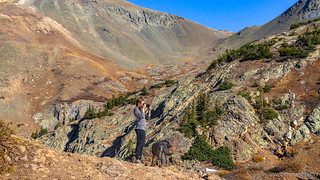
All captured by Devin, as she and Ollie watched from a safe distance.
Last to scale the wall was Dan. With his larger 35" tires, he chose a different route than the rest of us - the even steeper, buggy route - for his first attempt. Once again, Monte was spotting.

After a few attempts, it was clear that even with extra rubber, the traction on this part of the obstacle wasn't enough for a heavy Tacoma, and Dan reverted to the line the rest of us had taken. Attempted and achieved locker-less, just to keep Monte's ego in check! 
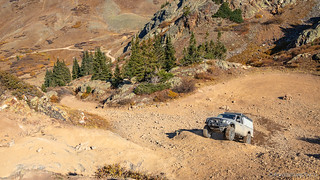


The hardest part behind us, there was less than a three-quarters of a mile left of the trail, and we wrapped that up reasonably quickly - a downclimb of a second rocky ledge, the only element of note over that distance.


Poughkeepsie Gulch had been a great trail, and the fact that it led right in to our first pass of the loop made it all the better. From its end, the road split - to the right, Hurricane Pass - a location we'd find ourselves at in a couple of days. To the left, California Pass via a shelf road to the sky - the direction we were headed now!


Part way up, at the apex of a switchback, a D6 dozer. Parked now, but clearly grading the pass before the snow hit for the winter. Quite a view from the office, if you ask me!
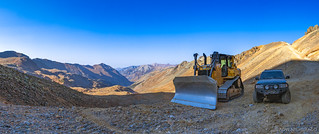

Lake Como, along the last leg of Poughkeepsie Gulch, and below Hurricane and California Passes.
At the top - as always - a sign. And the views - well, they were great too, the ridge leading to Hanson peak gleaming bright in the afternoon sun.


Unlike the trail up to California Pass - at least the way we'd come - the trip down was smooth sailing. Smooth enough, in fact, that we passed a full-sized Dodge dually headed (slowly) up the trail. As we made our way down, the mining history of this road became patently obvious, ruins and piles of tailings lining both sides of the valley.

One of these mines was the Frisco Mine, a few outbuildings and its mill in an apparent state of semi-restoration - or at least suspended deterioration. Hidden behind a large pile of tailings, I didn't even see the mill until I came barreling around the corner trying to catch up with the rest of the crew - having stopped for this photo of two cabins.
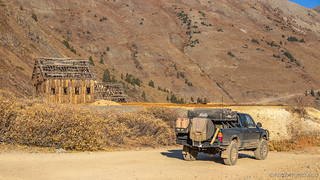
There - already parked and out of his truck - was Monte, doing the same thing I would have done regardless of his having stopped before me - exploring! I called ahead on the CB to let Mike and Dan know that we were out of the trucks, and joined him in another woodworkers heaven.
I mean seriously, just one of these 16"x16" old growth fir posts would be enough to keep me happy for many projects to come!


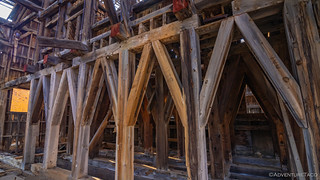
Knowing that Mike and Dan were waiting, and that we still had an entire pass to go before finding camp for the night, we didn't spend too long at the Frisco Mill, climbing back into our trucks just as Mike asked us which way he should turn at a fork he'd come to in the road.
Mike was - it turns out - at the ghost town of Animas Forks.
Established in 1873 and named in 1875, Animas Forks was positioned at the intersection of the three forks of the Animas River. A road to Silverton was constructed the same year, extending the Cinnamon Pass road from Lake City by nearly double. By 1885, 450 people called Animas Forks home during the summer, though few braved the harsh winters when most mining stopped. The town weathered boom and bust cycles until the 1920's when metal prices fell and the with them, the population. (informational sign)

Animas Forks was also our departure point for our second - and final - pass of the day: Engineer Pass. We'd tackle this pass from south-to-north, hoping to find camp somewhere after the pass and before we reached Lake City, some 20 miles to the east.

Heading up.

Many of the creeks and streams in Colorado have an eerie color to them, heavy metals and the chemicals used by mine operators having leached into the groundwater, poisoning the streams for centuries.
Moving as quickly as I could - which I must admit was not quickly at all - I found myself stopping constantly to capture the world around me - both in my brain as well as in photos. It's places like this that I've realized I could come back to - time and again - and always find something new to admire.
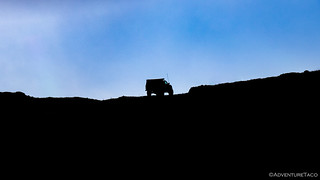
Dan driving into the sky.

The path of our ascent to Engineer Pass, now below us.
Hoping I wasn't holding everyone up too much, I stopped one more time.

And then again.

The aptly named, "Oh!, Point."
Intuition would suggest that Engineer Pass would be on a ridgeline - at the highest point of the saddle - between two valleys. It is on a ridgeline, but it is not at the highest point. This threw me off as we started our descent, and I wondered out loud - though to myself - if we'd just driven by the pass. Mike and Monte had been there before, and perhaps it wasn't anything new to them. 
Then, to my delight, I realized what was going on. We hadn't skipped the pass - it just wasn't where I expected it to be! We lined up for the requisite proof of our visit.



Beyond, the route forked. To the north, a winding road up Darley Mountain. This was the road I think we all wanted to try - across a scree field and up switchbacks to what must have been a dramatic overlook. It was, unfortunately, closed - rock and snow slides taking their tool - years earlier from the look of things.
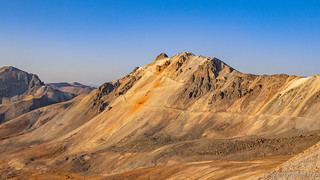
It was a good thing really - for two reasons: first, upon investigating the road on satelite imagery upon my return, I discovered that the road didn't actually go all the way to the top. It simply stopped in the middle of a switchback, which would have been so much fun™ to turn four trucks around on. Second - and more important at the time - it was getting late, and we still needed to find camp. As such, we headed east from Engineer Pass, towards some motorcycles we could see in the distance.

They were completely stopped it turns out - one of their group having trouble with the clutch. It'd given up the ghost during the long climb, with less than half a mile to go to the summit! A conversation with the riders revealed that they were considering a push to the top, since once there, the necessity of the clutch would be reduced and they could likely make it to Ouray with little need for gear shifts - the route mostly downhill.
We wished them luck and continued on - the road improving the lower in elevation we dropped. Now on high alert for a camp site, we careened down the hill, passing the ruins of old cabins and mines without much more than a second glance.
Except at the Rose Lime Kiln. The kiln was built in 1881 by local mason Samuel Tarkington for George S. Lee, a Capitol City, Colorado capitalist and mine developer. It was named after the owner's daughter - Rose Lee - and processed limestone mined from the Rose Lime Lode, an adjoining mining claim.
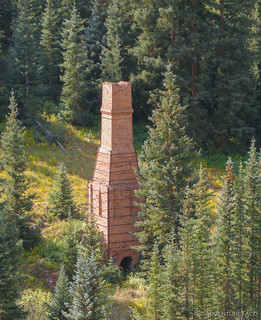
We ended up finding camp just a bit further east - a nice open space at just under 10,000 feet. One of our later nights to camp - and most definitely one of our longest days in the trucks - Monte thought it a good idea to check the state of his lower ball joints (LBJs) and their connection to the lower control arms he'd replaced just before the trip.

Everything was fine - to his relief - and we set about our usual evening activities. These included the creation and consumption of vast quantities of chips, salsa, and guacamole; campfire conversation, and of course a good amount of ribbing. We also returned to a conversation we'd had several times earlier in the trip - when, if ever, were we going to have a real wood campfire?
Little did we know that the time would come sooner than we envisioned - but that's a story for another day!














Very cool episode. Thanks for sharing. Living in Florida has advantages for exploration on the water which I spend a lot of time paddling. I run the Orlando Kayak Fishing Community on FB. Really want to head out west. I grew up in SF and remember the beauty of California, Nevada Oregon and Washington. The west has definite advantages when it comes to the old "ghost" towns. 5 years from retirement and working on my '01 Tacoma. Appreciate all the how to sections. I have used a few to make upgrades or repairs. Keep up the posts.
Glad you enjoyed Philippe! The Alpine Loop part of this whole adventure only gets better from here! ? ?
Great photos and story! Thanks again for sharing with us, I especially like all the photos. Be safe and be blessed.
Thanks Kenny! Lots more photos coming of some pretty awesome stuff!
Nice shots!
The place really is a bucket list destination for any 4 wheeler. We were there last in the summer of '19 and the snowfall was so heavy that most of the upper passes were still under a lot of snow. Some approaches it was several feet over the top of our truck.
Other places the trail would sort of Peter out under the snow, and it was a bit of a challenge to find the right path through. The big CATs had done a marvelous job of clearing though, and most of the trails were clear, I only got stuck in snow once the whole trip.
I can't wait to go back, COVID sidelined this years trip.
Bummer to hear that this year's trip was a bust for you Mike, but I totally understand the reasoning. That's part of why we went so late in the year - to hopefully (and it worked out) stay away from the hoards of people/traffic on the trail. Only really passed 1-2 other trucks each day (if that).
But hey, hopefully things are turning around here in the next 6-9 months, and you'll be able to get out there next summer! ?
WOW! Super wow, this is an amazing post. Love how to let the photos tell the whole story here. Such an awesome place. I can't wait. One week and counting. So excited.
Glad you enjoyed that one Brenan! The Alpine Loop was fantastic, and if you're headed there in a week, you're going to hit it at the perfect time of year. In fact, I was just back there (for only one afternoon unfortunately) about two weeks ago, and it was fab-u-lous. Haven't posted the story yet, and I'll probably be posting it just as you're experiencing it in real life. Have fun. Lots of fun. Go on a weekday if you can to have a little less traffic! ?
Awesome, thanks for the heads up. I think we're hitting it on Sunday and into Monday so hopefully Monday it will chill out. While I am out there, we're scheduled for Red Cone Pass, Wheeler Lake, Black Bear, Imogene, and then the Alpine Loop. If you have any other trails or peaks around that area that are a "must-see" let me know. I should have another day or two there and then off to Moab although I could just keep trekking through CO if the weather is nice.